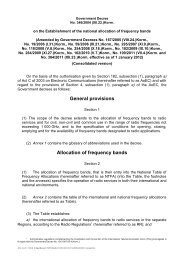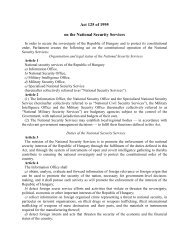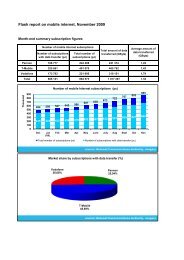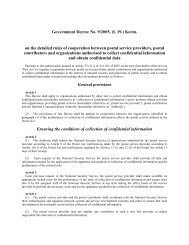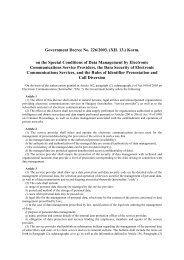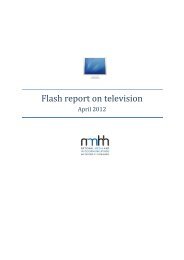The Hungarian Communications Market Developments and ...
The Hungarian Communications Market Developments and ...
The Hungarian Communications Market Developments and ...
Create successful ePaper yourself
Turn your PDF publications into a flip-book with our unique Google optimized e-Paper software.
<strong>The</strong> <strong>Hungarian</strong> <strong>Communications</strong> <strong>Market</strong> <strong>Developments</strong> <strong>and</strong> Regulation between 2004 <strong>and</strong> 2008<br />
Regulation of mobile call termination<br />
In the market “Voice call termination on individual mobile networks”<br />
(market 16) every authority, including the NHH introduced rigorous<br />
regulations.<br />
<strong>The</strong> general basic problem relating to call termination is the<br />
consequence of the so-called “calling party pays”-principle (CPPprinciple),<br />
according to which the subscriber originating the call pays<br />
the bill containing all expenses of the call. <strong>The</strong> CPP-principle takes<br />
effect both in the retail <strong>and</strong> the wholesale market. <strong>The</strong> charge of the<br />
call is defined by the subscriber’s service provider, which, upon calling<br />
a mobile telephone, contains, in addition to the expenses relating<br />
to the call, the termination rate payable to the mobile service provider.<br />
As the termination rate is not paid by the party called but the<br />
service provider of the caller, the provider of the termination service<br />
is not pressurised by its own consumers to keep termination rates<br />
low. <strong>The</strong> wholesale market is similarly affected. In the termination<br />
market, service providers buying call termination services are under<br />
pressure, as they have to terminate the calls of their subscribers.<br />
Analysing the effects of the CPP-principle, the Board established<br />
that the application of this principle makes it possible for mobile<br />
service providers to define their call termination rates for the most<br />
part independently of consumers.<br />
According to the 2005 <strong>and</strong> 2006 market analysis statements of the<br />
Board, voice call-termination services in the networks of individual<br />
mobile service providers constitute nationwide independent markets.<br />
It means that in respect of termination, every mobile service provider<br />
is in a monopolistic position with reference to its own network, i.e. it<br />
qualifies as a service provider with significant market power.<br />
Before the period under review, certain service providers had<br />
already been subject to regulation. <strong>The</strong> termination rates of T-Mobile<br />
(Magyar Telekom) were regulated two times (from 1 September 2003<br />
<strong>and</strong> from 15 July 2004) <strong>and</strong> the rates of Pannon one time (from 15<br />
July 2004). At the same time, the termination rates of Vodafone had<br />
not been subject to regulation before 2005. As a consequence of the<br />
different regulation of the service providers, which at that time fully<br />
complied with the EU regulatory framework, different termination<br />
rates has been established by 2005: the rates of T-Mobile, the service<br />
provider first undergoing regulation were the lowest, while those<br />
of previously unregulated Vodafone were the highest.<br />
During market analysis, the Board identified two major effects of<br />
market distortion as a consequence of excessive pricing applied in<br />
the wholesale market:<br />
1. High fixed-mobile retail rates.<br />
<strong>The</strong> unreasonably high call termination rate surfaces as expense<br />
on the part of the fixed service provider originating the call, which<br />
incorporates these expenses in its fixed mobile retail prices. Consequently,<br />
this may cause unreasonably high fixed-to-mobile rates,<br />
with direct effect on the customers of the fixed service provider.<br />
2. Income rearrangement not justified by cost relations between<br />
service providers.<br />
Extreme termination rates may cause unjustified income rearrangement<br />
between fixed <strong>and</strong> mobile service providers as well as<br />
between call origination <strong>and</strong> call termination mobile service providers.<br />
Unjustified income-re-arrangements may also come about if<br />
unjustified differences are detected in the call termination rates of<br />
mobile service providers.<br />
Mitigation or elimination of the market distortion effects identified<br />
can be realised by reducing the termination rates to a justifiable<br />
level. <strong>The</strong>refore, cost-based price regulation became the primary<br />
obligation of dealing with market failures, to which other obligations<br />
(transparency, non-discrimination, accounting separation, ensuring<br />
access <strong>and</strong> interconnection) were also added.<br />
For the definition of the cost-based rate level, the Board applied<br />
the internationally accepted <strong>and</strong> used method of Long Run Incremental<br />
Cost (LRIC). Both decisions obligated service providers to<br />
execute <strong>and</strong> submit to the NHH for approval a so-called TD-LRIC<br />
cost calculation, to ensure that service providers justify for their<br />
costs themselves. <strong>The</strong> detailed rules to be applied for the model are<br />
set forth in the decisions.<br />
However, the Authority did not accept the TD-LRIC calculations<br />
submitted by the service providers, as it found that none of them<br />
met the requirements <strong>and</strong> the rules. Consequently, termination rates<br />
have been established by the NHH itself. In 2005, this was carried<br />
out using the European benchmarks, <strong>and</strong> upon making the 2006<br />
decision, it was performed by applying the so-called BU-LRIC methodology<br />
developed by the Authority.<br />
<strong>The</strong> BU-LRIC cost model was prompted by the Authority’s recognition<br />
that the Authority shall have a so-called “gauging line”, a reference<br />
point as regards the specification of the cost-based obligation<br />
to be fulfilled by the service providers with significant market power.<br />
Moreover, NHH continuously confronted with dem<strong>and</strong>s arising both<br />
on the part of the service providers <strong>and</strong> the European Committee,<br />
according to which in its opinion the Authority should declare, in<br />
connection with the cost-based setting of call termination rates <strong>and</strong><br />
regarding the current situation of the electronic communications<br />
market, the extent <strong>and</strong> calculation method of the cost-based call<br />
termination rate as well as the principles <strong>and</strong> aspects taken into account<br />
for such calculation.<br />
<strong>The</strong> Board was fully aware of the significant difference between<br />
the average call termination rates previously applied by obliged<br />
service providers, <strong>and</strong> the results of the BU-LRIC method or any<br />
similar results, therefore, the immediate introduction of the rates so<br />
defined would have caused serious disruption in the operation of<br />
service providers. In addition, the Authority had to remember that the<br />
desired aim, the use of cost-based call termination rates in favour<br />
of ensuring the conditions of effective competition, was not to be




